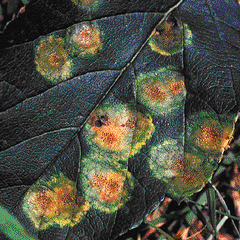The Ortho Home Gardener's Problem Solver
Malus: Cedar-Apple Rust
 Problem
Problem
Pale yellow spots appear on the leaves and fruit in mid- to late spring. These spots gradually enlarge, turn orange, and develop minute black dots. Small (1/16 inch) cups with fringed edges form on the lower surfaces of the leaves. Infected leaves and fruit may drop prematurely; the fruit is often deformed.
Analysis
This plant disease is caused by a fungus called Gymnosporangium juniperi-virginianae that affects both crabapples and certain species of juniper and red cedar. This disease cannot spread from crabapple to crabapple, or from juniper to juniper, but must alternate between the two. In the spring, spores from brown and orange galls on juniper or cedar are blown up to 3 miles to crabapple trees. During mild, wet weather, the spores germinate and infect the leaves and fruit, causing spotting and premature leaf and fruit drop. During the summer, spores are produced in small cups on the undersides of the leaves. These spores are blown back to junipers and cedars, causing new infections. For more information about cedar-apple rust on juniper, see Cedar-Apple Rust.
Solution
Cedar-apple rust cannot be controlled on this season's foliage and fruit. Next spring, spray trees with a fungicide containing chlorothalonil when the flower buds turn pink, again when 75 percent of the petals have fallen from the blossoms, and once more 10 days later. If possible, do not plant crabapples within several hundred yards of junipers or red cedar.
Copyright©1997. Books That Work.
Copyright©1982, 1993, 1997. Monsanto Company.
Visit Books That Work at http://www.btw.com
